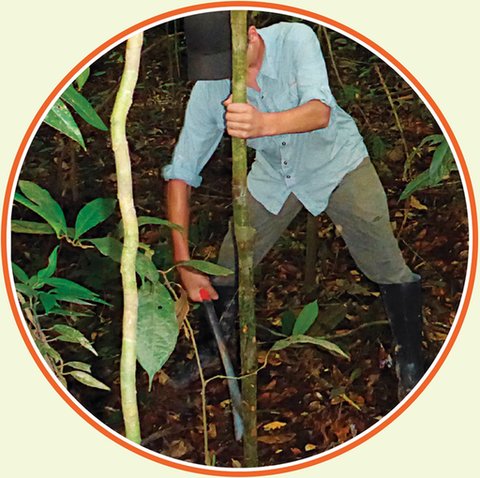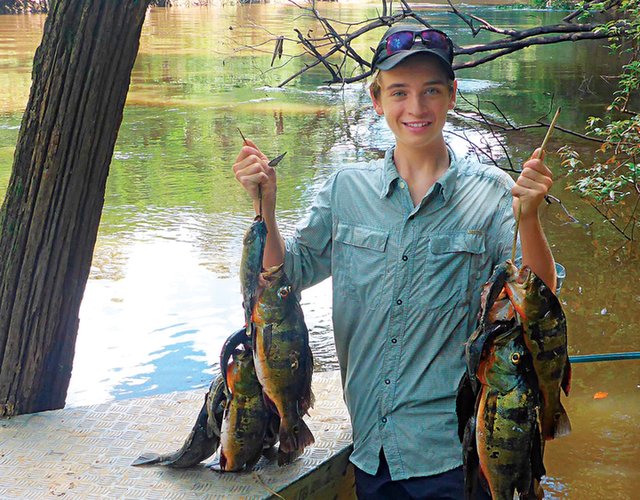KaneisdeepintheAmazonrain forest,intheremoteMatsés (MAT-sess)NationalReserve.Here,milesawayfromanytownsorfarms,the Matsés tribeofpeopleliveinthetraditionalway,completelyoffthegrid.Noelectricity.Noplumbing.Nogrocerystoresorcellphonesorvehicles.Justmilesofwaterwaysanddensejungleteemingwithwildbirds,animals,and insects.
Kane traveledfortwodaysuptheAmazonRiverandthenalongsmallerriverstoreachoneoftheremote Matsés villages.Hiscompanionswerehisadventurerfather—Paul Hameister—andphotographerDomFarrell.Theirlocalguidesandteachers were Sergio; Harnan,chiefofthe Matsés tribe; andHarnan’sfather, Armando.
Kanewasonamission.HewantedtolearnhowtoliveliketheMatss.Itwasn’tlongbeforehefoundoutjusthowchallengingthatcould be.

Likethe Matsés, Kanehadtomakealmosteverythingheneededtosurvive.The rain forest providedallthebasicmaterials.Kanejustneededtolearnhowtouse them.
Hegothisfirstlessonsatthevillage.Hisbasictoolwasakindofa knifecalledamachete.Heusedittochopdownwoodandhackintotoughrain forestvines.The Matsés usemachetesformakingeverythingfromfirewoodtofishing rods.
Kanetraveled toanevenmoreremoteareabydugoutcanoe,wherehelearnedhisnextlesson.IfKanewantedlunch,hewasgoingtohavetocatchorkillsomething.Hisguidestaughthimhowtomakeafishingrodfromasmall,thintreecutoffatitsbase.Heburnedittostrengthenit,thenpeeledoffthebark.Then heattachedsomefishinglineanda hook.Leftovermeatscrapswereusedasbait.Alongwithsharp-toothedpiranhas,Kanecaughtwolffishandpeacockbass.Heevengotprettygoodatgutting them.


Kaneusesamachetetocutawayathintree.Withit,hecanmakeafishing rod.

Kanewassuccessfulasafisherman!
Catchingandpreparingthefishwasn’tenough,though.Nofire,nodinner.Kanelearnedhowtochopuptreebarkforstartingafire.Heheldamatchtoit,hopingforaspark.Itlit!Carefullyhebreathedlifeintoit,thenfed itwithsmallsticks.Ahhh. . .fire.ThosefishroastingoverKane’sfiresmelledbetterthananythinghecouldhave imagined.
Kanelearnedotherlessonshere.Hisguidesshowedhimhowtomakeabridgefromafallenlogtocrossafast-movingcreek.Usinglongbranchesaspolesforbalance,Kaneslowlymadehisway across.
Theyreturnedtocampatdusk.Kanewasreadyforbed.Butfirsthehadtobuildashelter.TheMatséstraditionallybuildpermanentsheltersfromwoodandwovenpalmbranches.Buthere,Kanelearnedtobuildatemporaryshelter.Hecuttwobigtreebranches,eachwithaYatthetop,anddugthemintotheground.Astrongbranchbetweenthetwo Y’smadeanA-framefora tarp.Hetieddownthetarpedgeswithvines.Forafloor,helaiddownlargepalmbranches.Finally,heputhissleepmatunderthetarp.Exhausted,hefellasleep immediately.

MatsésNationalReserve
Bolivia
Brazil
Colombia
Ecuador
Guyana
Peru
Venezuela
AtlanticOcean
PacificOcean

Amazonrainforest

Matsés NationalReserve
